Organizational Behavior Report: Leadership and Team Effectiveness
VerifiedAdded on 2020/07/23
|10
|3711
|69
Report
AI Summary
This report provides a comprehensive overview of organizational behavior, focusing on the impact of culture, politics, and power on individual and team behavior. It delves into content and process theories of motivation, including Maslow's hierarchy, Herzberg's theory, and Vroom's expectancy theory, alongside motivational techniques like job design and rewards. The report examines factors that differentiate effective from non-effective teams and discusses the concepts and philosophies of organizational behavior within the context of 4com Plc. It highlights the importance of leadership, organizational culture, and motivation in shaping employee behavior and driving team performance. The report also discusses the influence of globalization and network theory on workplace dynamics and concludes by emphasizing the importance of aligning individual needs with organizational goals for enhanced productivity and success.
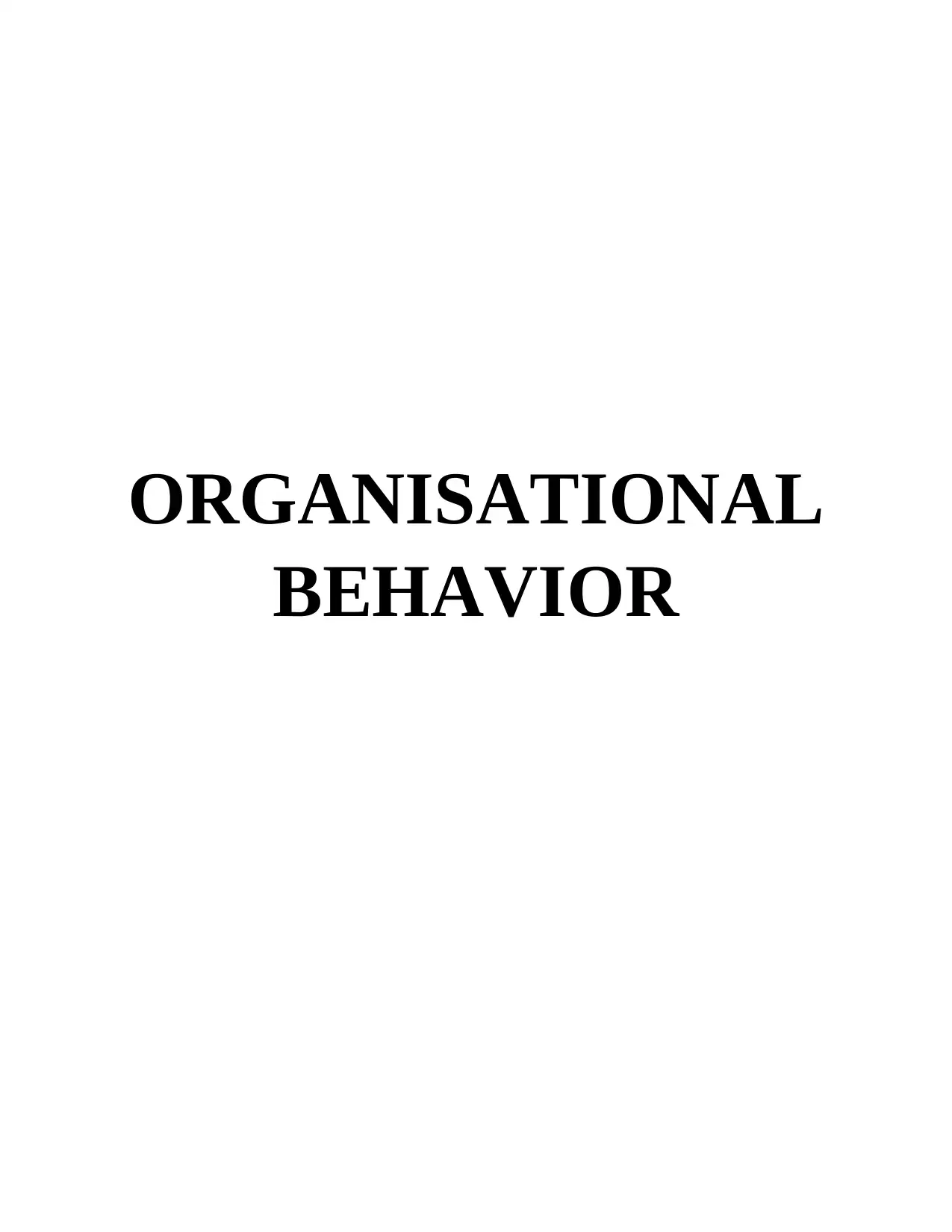
ORGANISATIONAL
BEHAVIOR
BEHAVIOR
Paraphrase This Document
Need a fresh take? Get an instant paraphrase of this document with our AI Paraphraser
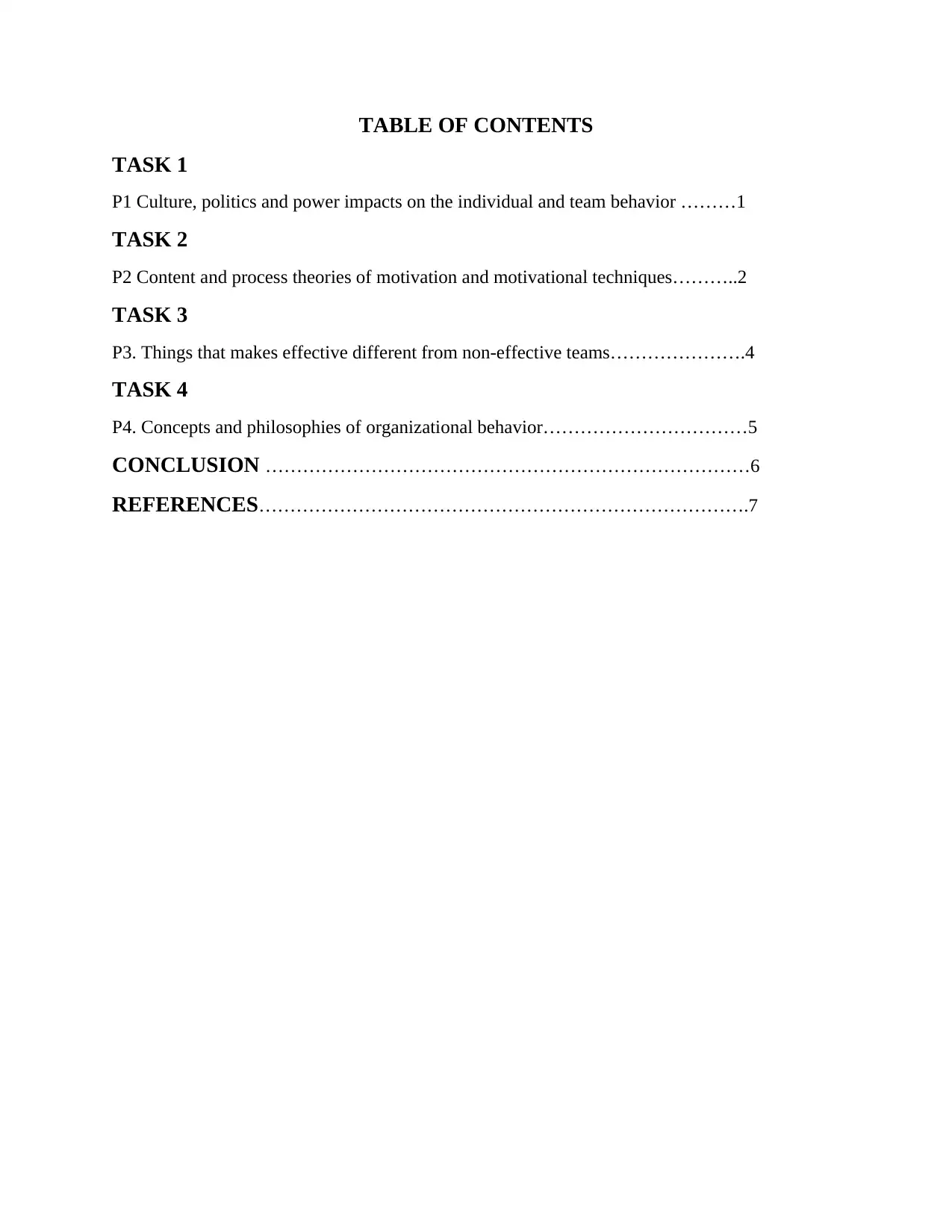
TABLE OF CONTENTS
TASK 1
P1 Culture, politics and power impacts on the individual and team behavior ………1
TASK 2
P2 Content and process theories of motivation and motivational techniques………..2
TASK 3
P3. Things that makes effective different from non-effective teams………………….4
TASK 4
P4. Concepts and philosophies of organizational behavior……………………………5
CONCLUSION ……………………………………………………………………6
REFERENCES…………………………………………………………………….7
TASK 1
P1 Culture, politics and power impacts on the individual and team behavior ………1
TASK 2
P2 Content and process theories of motivation and motivational techniques………..2
TASK 3
P3. Things that makes effective different from non-effective teams………………….4
TASK 4
P4. Concepts and philosophies of organizational behavior……………………………5
CONCLUSION ……………………………………………………………………6
REFERENCES…………………………………………………………………….7
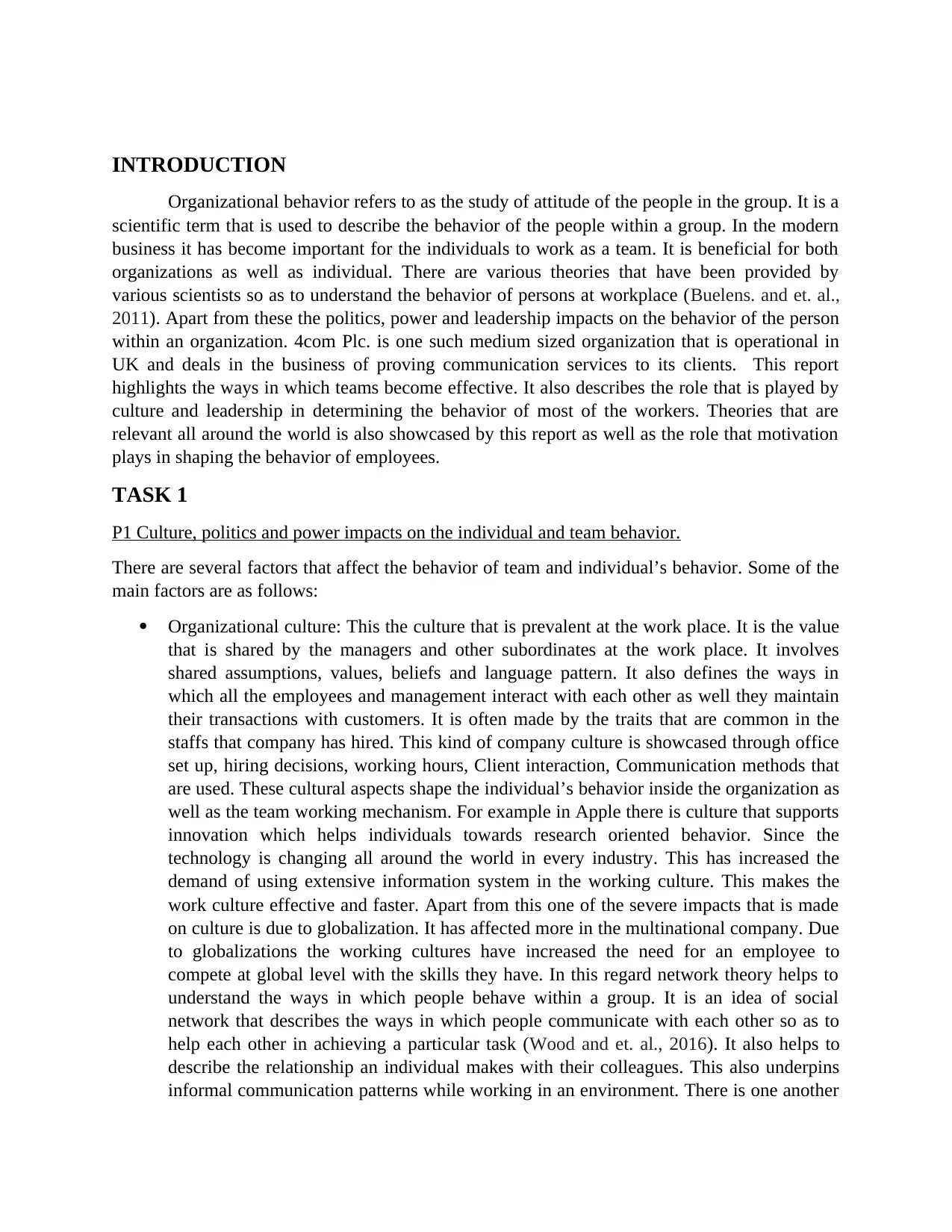
INTRODUCTION
Organizational behavior refers to as the study of attitude of the people in the group. It is a
scientific term that is used to describe the behavior of the people within a group. In the modern
business it has become important for the individuals to work as a team. It is beneficial for both
organizations as well as individual. There are various theories that have been provided by
various scientists so as to understand the behavior of persons at workplace (Buelens. and et. al.,
2011). Apart from these the politics, power and leadership impacts on the behavior of the person
within an organization. 4com Plc. is one such medium sized organization that is operational in
UK and deals in the business of proving communication services to its clients. This report
highlights the ways in which teams become effective. It also describes the role that is played by
culture and leadership in determining the behavior of most of the workers. Theories that are
relevant all around the world is also showcased by this report as well as the role that motivation
plays in shaping the behavior of employees.
TASK 1
P1 Culture, politics and power impacts on the individual and team behavior.
There are several factors that affect the behavior of team and individual’s behavior. Some of the
main factors are as follows:
Organizational culture: This the culture that is prevalent at the work place. It is the value
that is shared by the managers and other subordinates at the work place. It involves
shared assumptions, values, beliefs and language pattern. It also defines the ways in
which all the employees and management interact with each other as well they maintain
their transactions with customers. It is often made by the traits that are common in the
staffs that company has hired. This kind of company culture is showcased through office
set up, hiring decisions, working hours, Client interaction, Communication methods that
are used. These cultural aspects shape the individual’s behavior inside the organization as
well as the team working mechanism. For example in Apple there is culture that supports
innovation which helps individuals towards research oriented behavior. Since the
technology is changing all around the world in every industry. This has increased the
demand of using extensive information system in the working culture. This makes the
work culture effective and faster. Apart from this one of the severe impacts that is made
on culture is due to globalization. It has affected more in the multinational company. Due
to globalizations the working cultures have increased the need for an employee to
compete at global level with the skills they have. In this regard network theory helps to
understand the ways in which people behave within a group. It is an idea of social
network that describes the ways in which people communicate with each other so as to
help each other in achieving a particular task (Wood and et. al., 2016). It also helps to
describe the relationship an individual makes with their colleagues. This also underpins
informal communication patterns while working in an environment. There is one another
Organizational behavior refers to as the study of attitude of the people in the group. It is a
scientific term that is used to describe the behavior of the people within a group. In the modern
business it has become important for the individuals to work as a team. It is beneficial for both
organizations as well as individual. There are various theories that have been provided by
various scientists so as to understand the behavior of persons at workplace (Buelens. and et. al.,
2011). Apart from these the politics, power and leadership impacts on the behavior of the person
within an organization. 4com Plc. is one such medium sized organization that is operational in
UK and deals in the business of proving communication services to its clients. This report
highlights the ways in which teams become effective. It also describes the role that is played by
culture and leadership in determining the behavior of most of the workers. Theories that are
relevant all around the world is also showcased by this report as well as the role that motivation
plays in shaping the behavior of employees.
TASK 1
P1 Culture, politics and power impacts on the individual and team behavior.
There are several factors that affect the behavior of team and individual’s behavior. Some of the
main factors are as follows:
Organizational culture: This the culture that is prevalent at the work place. It is the value
that is shared by the managers and other subordinates at the work place. It involves
shared assumptions, values, beliefs and language pattern. It also defines the ways in
which all the employees and management interact with each other as well they maintain
their transactions with customers. It is often made by the traits that are common in the
staffs that company has hired. This kind of company culture is showcased through office
set up, hiring decisions, working hours, Client interaction, Communication methods that
are used. These cultural aspects shape the individual’s behavior inside the organization as
well as the team working mechanism. For example in Apple there is culture that supports
innovation which helps individuals towards research oriented behavior. Since the
technology is changing all around the world in every industry. This has increased the
demand of using extensive information system in the working culture. This makes the
work culture effective and faster. Apart from this one of the severe impacts that is made
on culture is due to globalization. It has affected more in the multinational company. Due
to globalizations the working cultures have increased the need for an employee to
compete at global level with the skills they have. In this regard network theory helps to
understand the ways in which people behave within a group. It is an idea of social
network that describes the ways in which people communicate with each other so as to
help each other in achieving a particular task (Wood and et. al., 2016). It also helps to
describe the relationship an individual makes with their colleagues. This also underpins
informal communication patterns while working in an environment. There is one another
⊘ This is a preview!⊘
Do you want full access?
Subscribe today to unlock all pages.

Trusted by 1+ million students worldwide
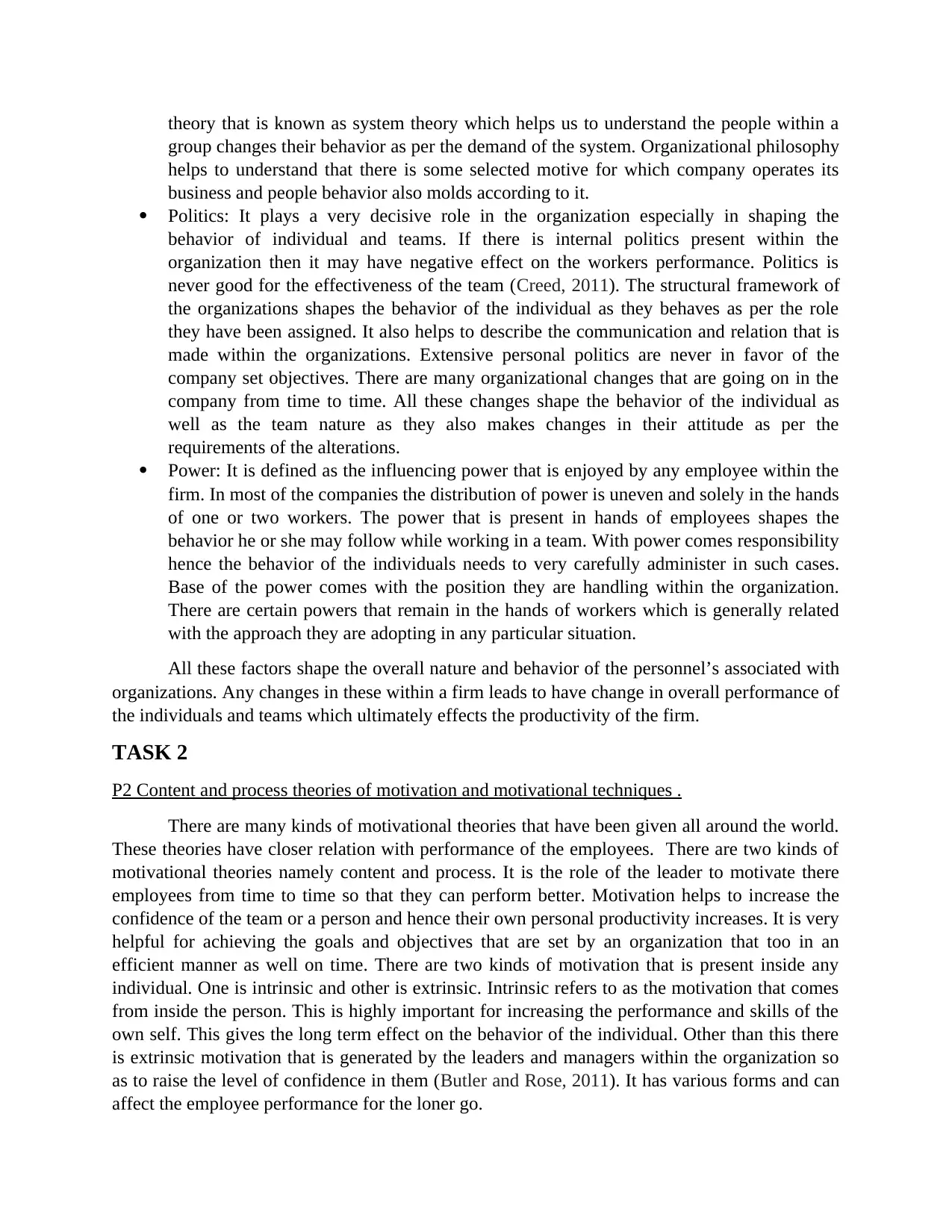
theory that is known as system theory which helps us to understand the people within a
group changes their behavior as per the demand of the system. Organizational philosophy
helps to understand that there is some selected motive for which company operates its
business and people behavior also molds according to it.
Politics: It plays a very decisive role in the organization especially in shaping the
behavior of individual and teams. If there is internal politics present within the
organization then it may have negative effect on the workers performance. Politics is
never good for the effectiveness of the team (Creed, 2011). The structural framework of
the organizations shapes the behavior of the individual as they behaves as per the role
they have been assigned. It also helps to describe the communication and relation that is
made within the organizations. Extensive personal politics are never in favor of the
company set objectives. There are many organizational changes that are going on in the
company from time to time. All these changes shape the behavior of the individual as
well as the team nature as they also makes changes in their attitude as per the
requirements of the alterations.
Power: It is defined as the influencing power that is enjoyed by any employee within the
firm. In most of the companies the distribution of power is uneven and solely in the hands
of one or two workers. The power that is present in hands of employees shapes the
behavior he or she may follow while working in a team. With power comes responsibility
hence the behavior of the individuals needs to very carefully administer in such cases.
Base of the power comes with the position they are handling within the organization.
There are certain powers that remain in the hands of workers which is generally related
with the approach they are adopting in any particular situation.
All these factors shape the overall nature and behavior of the personnel’s associated with
organizations. Any changes in these within a firm leads to have change in overall performance of
the individuals and teams which ultimately effects the productivity of the firm.
TASK 2
P2 Content and process theories of motivation and motivational techniques .
There are many kinds of motivational theories that have been given all around the world.
These theories have closer relation with performance of the employees. There are two kinds of
motivational theories namely content and process. It is the role of the leader to motivate there
employees from time to time so that they can perform better. Motivation helps to increase the
confidence of the team or a person and hence their own personal productivity increases. It is very
helpful for achieving the goals and objectives that are set by an organization that too in an
efficient manner as well on time. There are two kinds of motivation that is present inside any
individual. One is intrinsic and other is extrinsic. Intrinsic refers to as the motivation that comes
from inside the person. This is highly important for increasing the performance and skills of the
own self. This gives the long term effect on the behavior of the individual. Other than this there
is extrinsic motivation that is generated by the leaders and managers within the organization so
as to raise the level of confidence in them (Butler and Rose, 2011). It has various forms and can
affect the employee performance for the loner go.
group changes their behavior as per the demand of the system. Organizational philosophy
helps to understand that there is some selected motive for which company operates its
business and people behavior also molds according to it.
Politics: It plays a very decisive role in the organization especially in shaping the
behavior of individual and teams. If there is internal politics present within the
organization then it may have negative effect on the workers performance. Politics is
never good for the effectiveness of the team (Creed, 2011). The structural framework of
the organizations shapes the behavior of the individual as they behaves as per the role
they have been assigned. It also helps to describe the communication and relation that is
made within the organizations. Extensive personal politics are never in favor of the
company set objectives. There are many organizational changes that are going on in the
company from time to time. All these changes shape the behavior of the individual as
well as the team nature as they also makes changes in their attitude as per the
requirements of the alterations.
Power: It is defined as the influencing power that is enjoyed by any employee within the
firm. In most of the companies the distribution of power is uneven and solely in the hands
of one or two workers. The power that is present in hands of employees shapes the
behavior he or she may follow while working in a team. With power comes responsibility
hence the behavior of the individuals needs to very carefully administer in such cases.
Base of the power comes with the position they are handling within the organization.
There are certain powers that remain in the hands of workers which is generally related
with the approach they are adopting in any particular situation.
All these factors shape the overall nature and behavior of the personnel’s associated with
organizations. Any changes in these within a firm leads to have change in overall performance of
the individuals and teams which ultimately effects the productivity of the firm.
TASK 2
P2 Content and process theories of motivation and motivational techniques .
There are many kinds of motivational theories that have been given all around the world.
These theories have closer relation with performance of the employees. There are two kinds of
motivational theories namely content and process. It is the role of the leader to motivate there
employees from time to time so that they can perform better. Motivation helps to increase the
confidence of the team or a person and hence their own personal productivity increases. It is very
helpful for achieving the goals and objectives that are set by an organization that too in an
efficient manner as well on time. There are two kinds of motivation that is present inside any
individual. One is intrinsic and other is extrinsic. Intrinsic refers to as the motivation that comes
from inside the person. This is highly important for increasing the performance and skills of the
own self. This gives the long term effect on the behavior of the individual. Other than this there
is extrinsic motivation that is generated by the leaders and managers within the organization so
as to raise the level of confidence in them (Butler and Rose, 2011). It has various forms and can
affect the employee performance for the loner go.
Paraphrase This Document
Need a fresh take? Get an instant paraphrase of this document with our AI Paraphraser
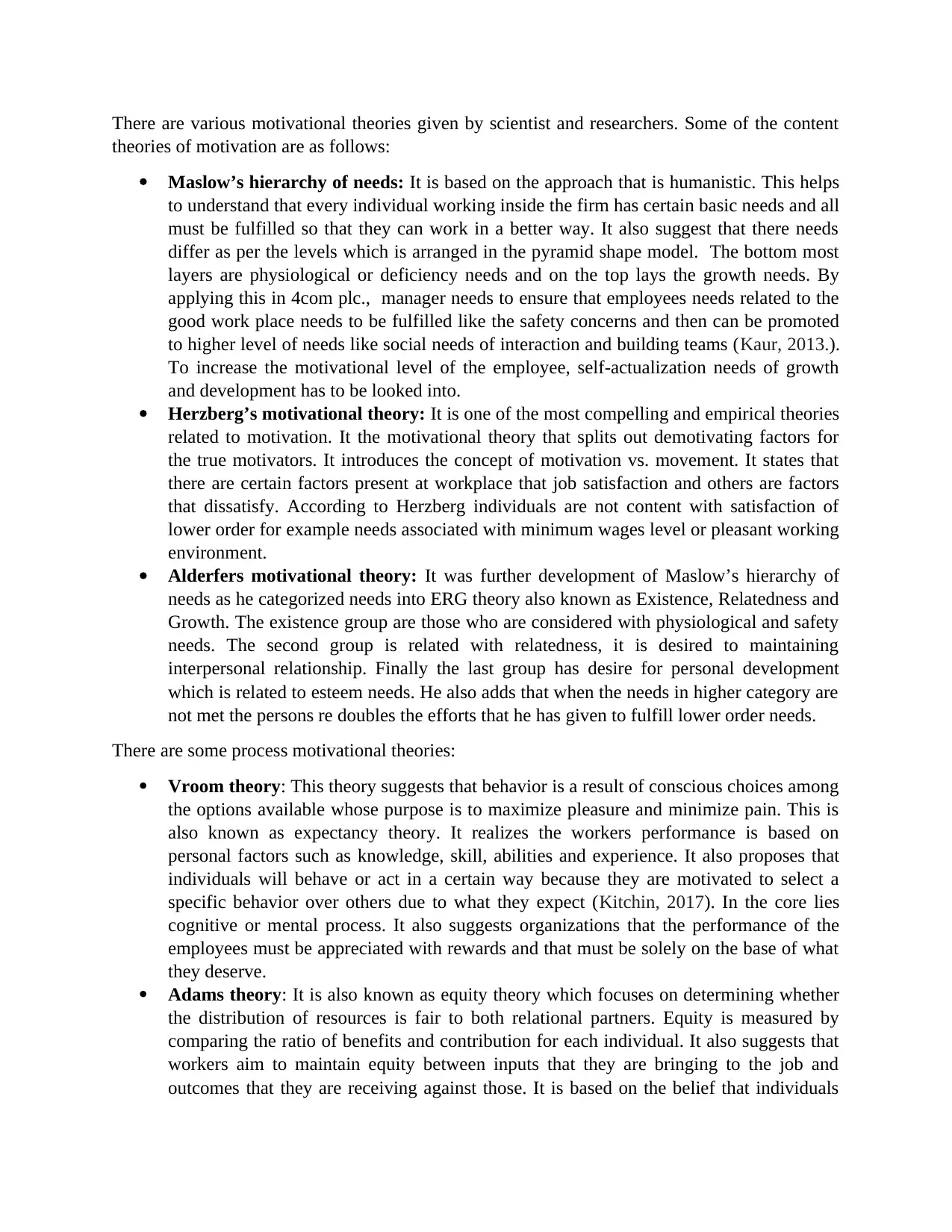
There are various motivational theories given by scientist and researchers. Some of the content
theories of motivation are as follows:
Maslow’s hierarchy of needs: It is based on the approach that is humanistic. This helps
to understand that every individual working inside the firm has certain basic needs and all
must be fulfilled so that they can work in a better way. It also suggest that there needs
differ as per the levels which is arranged in the pyramid shape model. The bottom most
layers are physiological or deficiency needs and on the top lays the growth needs. By
applying this in 4com plc., manager needs to ensure that employees needs related to the
good work place needs to be fulfilled like the safety concerns and then can be promoted
to higher level of needs like social needs of interaction and building teams (Kaur, 2013.).
To increase the motivational level of the employee, self-actualization needs of growth
and development has to be looked into.
Herzberg’s motivational theory: It is one of the most compelling and empirical theories
related to motivation. It the motivational theory that splits out demotivating factors for
the true motivators. It introduces the concept of motivation vs. movement. It states that
there are certain factors present at workplace that job satisfaction and others are factors
that dissatisfy. According to Herzberg individuals are not content with satisfaction of
lower order for example needs associated with minimum wages level or pleasant working
environment.
Alderfers motivational theory: It was further development of Maslow’s hierarchy of
needs as he categorized needs into ERG theory also known as Existence, Relatedness and
Growth. The existence group are those who are considered with physiological and safety
needs. The second group is related with relatedness, it is desired to maintaining
interpersonal relationship. Finally the last group has desire for personal development
which is related to esteem needs. He also adds that when the needs in higher category are
not met the persons re doubles the efforts that he has given to fulfill lower order needs.
There are some process motivational theories:
Vroom theory: This theory suggests that behavior is a result of conscious choices among
the options available whose purpose is to maximize pleasure and minimize pain. This is
also known as expectancy theory. It realizes the workers performance is based on
personal factors such as knowledge, skill, abilities and experience. It also proposes that
individuals will behave or act in a certain way because they are motivated to select a
specific behavior over others due to what they expect (Kitchin, 2017). In the core lies
cognitive or mental process. It also suggests organizations that the performance of the
employees must be appreciated with rewards and that must be solely on the base of what
they deserve.
Adams theory: It is also known as equity theory which focuses on determining whether
the distribution of resources is fair to both relational partners. Equity is measured by
comparing the ratio of benefits and contribution for each individual. It also suggests that
workers aim to maintain equity between inputs that they are bringing to the job and
outcomes that they are receiving against those. It is based on the belief that individuals
theories of motivation are as follows:
Maslow’s hierarchy of needs: It is based on the approach that is humanistic. This helps
to understand that every individual working inside the firm has certain basic needs and all
must be fulfilled so that they can work in a better way. It also suggest that there needs
differ as per the levels which is arranged in the pyramid shape model. The bottom most
layers are physiological or deficiency needs and on the top lays the growth needs. By
applying this in 4com plc., manager needs to ensure that employees needs related to the
good work place needs to be fulfilled like the safety concerns and then can be promoted
to higher level of needs like social needs of interaction and building teams (Kaur, 2013.).
To increase the motivational level of the employee, self-actualization needs of growth
and development has to be looked into.
Herzberg’s motivational theory: It is one of the most compelling and empirical theories
related to motivation. It the motivational theory that splits out demotivating factors for
the true motivators. It introduces the concept of motivation vs. movement. It states that
there are certain factors present at workplace that job satisfaction and others are factors
that dissatisfy. According to Herzberg individuals are not content with satisfaction of
lower order for example needs associated with minimum wages level or pleasant working
environment.
Alderfers motivational theory: It was further development of Maslow’s hierarchy of
needs as he categorized needs into ERG theory also known as Existence, Relatedness and
Growth. The existence group are those who are considered with physiological and safety
needs. The second group is related with relatedness, it is desired to maintaining
interpersonal relationship. Finally the last group has desire for personal development
which is related to esteem needs. He also adds that when the needs in higher category are
not met the persons re doubles the efforts that he has given to fulfill lower order needs.
There are some process motivational theories:
Vroom theory: This theory suggests that behavior is a result of conscious choices among
the options available whose purpose is to maximize pleasure and minimize pain. This is
also known as expectancy theory. It realizes the workers performance is based on
personal factors such as knowledge, skill, abilities and experience. It also proposes that
individuals will behave or act in a certain way because they are motivated to select a
specific behavior over others due to what they expect (Kitchin, 2017). In the core lies
cognitive or mental process. It also suggests organizations that the performance of the
employees must be appreciated with rewards and that must be solely on the base of what
they deserve.
Adams theory: It is also known as equity theory which focuses on determining whether
the distribution of resources is fair to both relational partners. Equity is measured by
comparing the ratio of benefits and contribution for each individual. It also suggests that
workers aim to maintain equity between inputs that they are bringing to the job and
outcomes that they are receiving against those. It is based on the belief that individuals
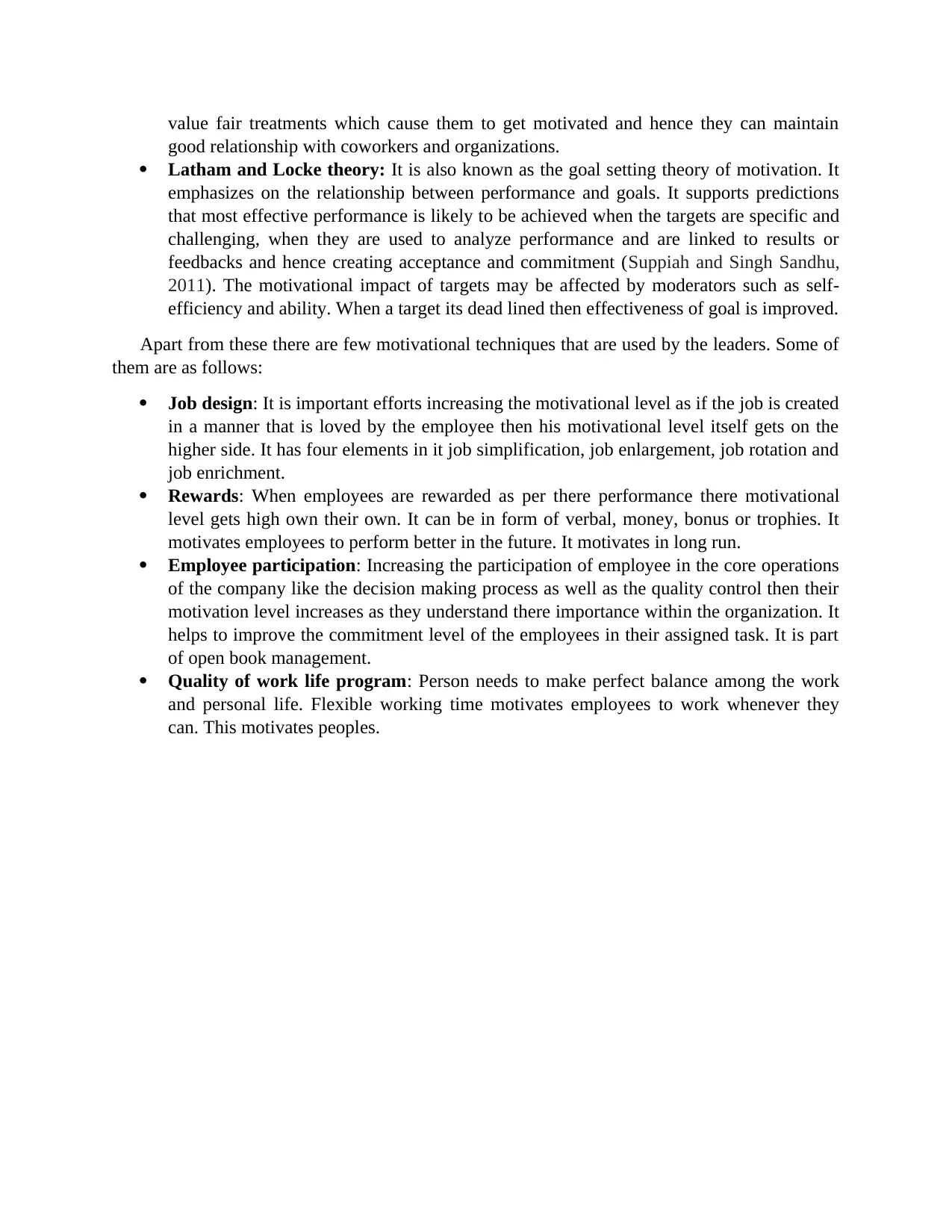
value fair treatments which cause them to get motivated and hence they can maintain
good relationship with coworkers and organizations.
Latham and Locke theory: It is also known as the goal setting theory of motivation. It
emphasizes on the relationship between performance and goals. It supports predictions
that most effective performance is likely to be achieved when the targets are specific and
challenging, when they are used to analyze performance and are linked to results or
feedbacks and hence creating acceptance and commitment (Suppiah and Singh Sandhu,
2011). The motivational impact of targets may be affected by moderators such as self-
efficiency and ability. When a target its dead lined then effectiveness of goal is improved.
Apart from these there are few motivational techniques that are used by the leaders. Some of
them are as follows:
Job design: It is important efforts increasing the motivational level as if the job is created
in a manner that is loved by the employee then his motivational level itself gets on the
higher side. It has four elements in it job simplification, job enlargement, job rotation and
job enrichment.
Rewards: When employees are rewarded as per there performance there motivational
level gets high own their own. It can be in form of verbal, money, bonus or trophies. It
motivates employees to perform better in the future. It motivates in long run.
Employee participation: Increasing the participation of employee in the core operations
of the company like the decision making process as well as the quality control then their
motivation level increases as they understand there importance within the organization. It
helps to improve the commitment level of the employees in their assigned task. It is part
of open book management.
Quality of work life program: Person needs to make perfect balance among the work
and personal life. Flexible working time motivates employees to work whenever they
can. This motivates peoples.
good relationship with coworkers and organizations.
Latham and Locke theory: It is also known as the goal setting theory of motivation. It
emphasizes on the relationship between performance and goals. It supports predictions
that most effective performance is likely to be achieved when the targets are specific and
challenging, when they are used to analyze performance and are linked to results or
feedbacks and hence creating acceptance and commitment (Suppiah and Singh Sandhu,
2011). The motivational impact of targets may be affected by moderators such as self-
efficiency and ability. When a target its dead lined then effectiveness of goal is improved.
Apart from these there are few motivational techniques that are used by the leaders. Some of
them are as follows:
Job design: It is important efforts increasing the motivational level as if the job is created
in a manner that is loved by the employee then his motivational level itself gets on the
higher side. It has four elements in it job simplification, job enlargement, job rotation and
job enrichment.
Rewards: When employees are rewarded as per there performance there motivational
level gets high own their own. It can be in form of verbal, money, bonus or trophies. It
motivates employees to perform better in the future. It motivates in long run.
Employee participation: Increasing the participation of employee in the core operations
of the company like the decision making process as well as the quality control then their
motivation level increases as they understand there importance within the organization. It
helps to improve the commitment level of the employees in their assigned task. It is part
of open book management.
Quality of work life program: Person needs to make perfect balance among the work
and personal life. Flexible working time motivates employees to work whenever they
can. This motivates peoples.
⊘ This is a preview!⊘
Do you want full access?
Subscribe today to unlock all pages.

Trusted by 1+ million students worldwide
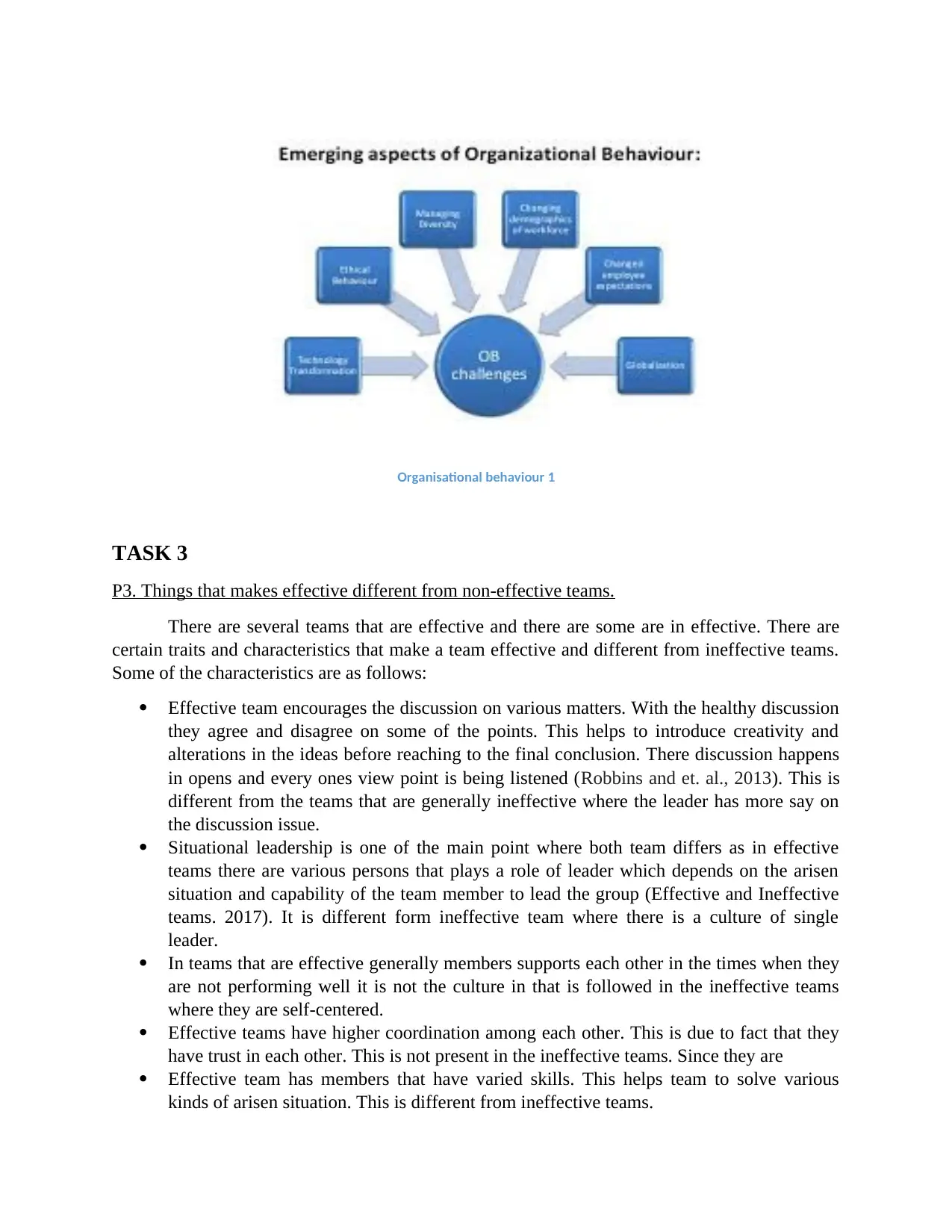
Organisational behaviour 1
TASK 3
P3. Things that makes effective different from non-effective teams.
There are several teams that are effective and there are some are in effective. There are
certain traits and characteristics that make a team effective and different from ineffective teams.
Some of the characteristics are as follows:
Effective team encourages the discussion on various matters. With the healthy discussion
they agree and disagree on some of the points. This helps to introduce creativity and
alterations in the ideas before reaching to the final conclusion. There discussion happens
in opens and every ones view point is being listened (Robbins and et. al., 2013). This is
different from the teams that are generally ineffective where the leader has more say on
the discussion issue.
Situational leadership is one of the main point where both team differs as in effective
teams there are various persons that plays a role of leader which depends on the arisen
situation and capability of the team member to lead the group (Effective and Ineffective
teams. 2017). It is different form ineffective team where there is a culture of single
leader.
In teams that are effective generally members supports each other in the times when they
are not performing well it is not the culture in that is followed in the ineffective teams
where they are self-centered.
Effective teams have higher coordination among each other. This is due to fact that they
have trust in each other. This is not present in the ineffective teams. Since they are
Effective team has members that have varied skills. This helps team to solve various
kinds of arisen situation. This is different from ineffective teams.
TASK 3
P3. Things that makes effective different from non-effective teams.
There are several teams that are effective and there are some are in effective. There are
certain traits and characteristics that make a team effective and different from ineffective teams.
Some of the characteristics are as follows:
Effective team encourages the discussion on various matters. With the healthy discussion
they agree and disagree on some of the points. This helps to introduce creativity and
alterations in the ideas before reaching to the final conclusion. There discussion happens
in opens and every ones view point is being listened (Robbins and et. al., 2013). This is
different from the teams that are generally ineffective where the leader has more say on
the discussion issue.
Situational leadership is one of the main point where both team differs as in effective
teams there are various persons that plays a role of leader which depends on the arisen
situation and capability of the team member to lead the group (Effective and Ineffective
teams. 2017). It is different form ineffective team where there is a culture of single
leader.
In teams that are effective generally members supports each other in the times when they
are not performing well it is not the culture in that is followed in the ineffective teams
where they are self-centered.
Effective teams have higher coordination among each other. This is due to fact that they
have trust in each other. This is not present in the ineffective teams. Since they are
Effective team has members that have varied skills. This helps team to solve various
kinds of arisen situation. This is different from ineffective teams.
Paraphrase This Document
Need a fresh take? Get an instant paraphrase of this document with our AI Paraphraser
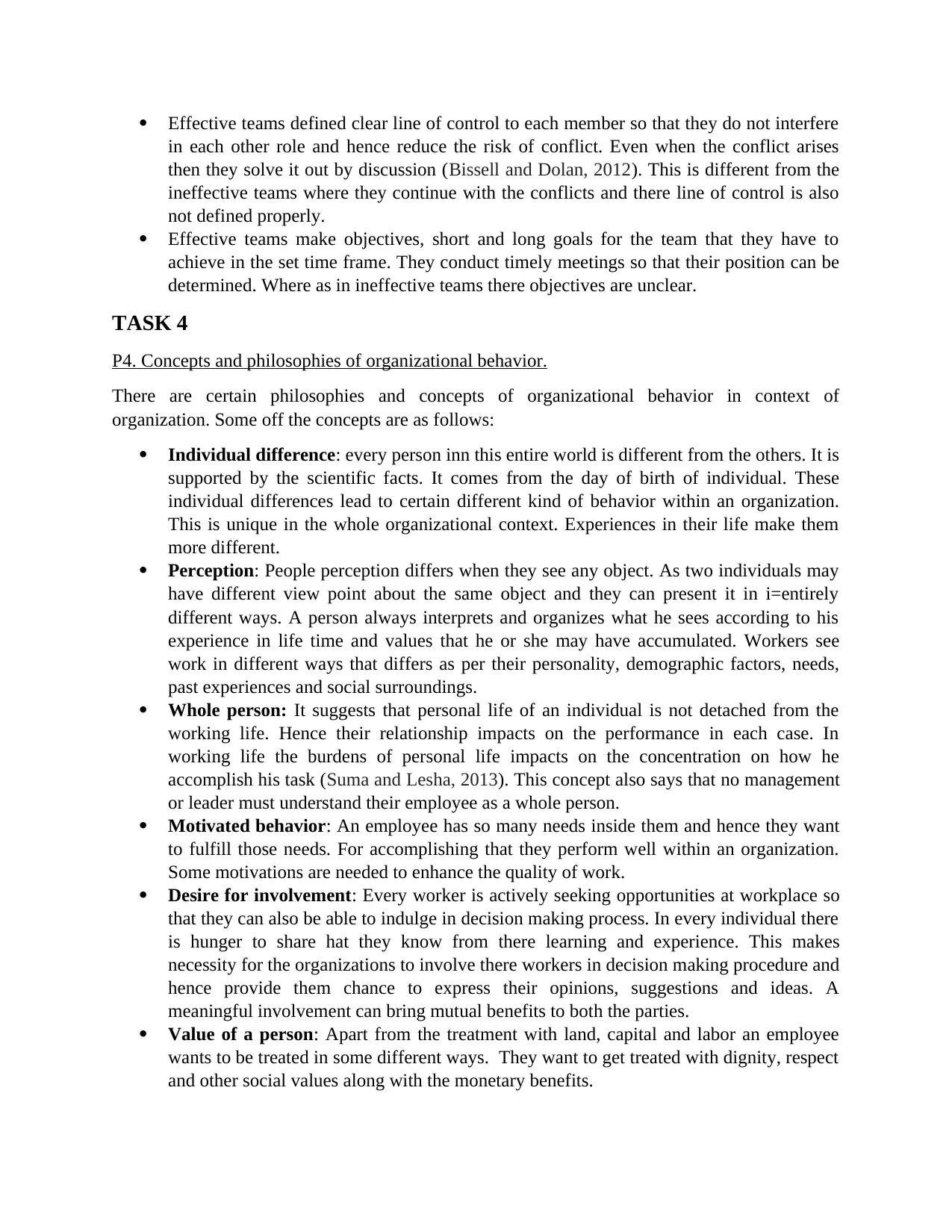
Effective teams defined clear line of control to each member so that they do not interfere
in each other role and hence reduce the risk of conflict. Even when the conflict arises
then they solve it out by discussion (Bissell and Dolan, 2012). This is different from the
ineffective teams where they continue with the conflicts and there line of control is also
not defined properly.
Effective teams make objectives, short and long goals for the team that they have to
achieve in the set time frame. They conduct timely meetings so that their position can be
determined. Where as in ineffective teams there objectives are unclear.
TASK 4
P4. Concepts and philosophies of organizational behavior.
There are certain philosophies and concepts of organizational behavior in context of
organization. Some off the concepts are as follows:
Individual difference: every person inn this entire world is different from the others. It is
supported by the scientific facts. It comes from the day of birth of individual. These
individual differences lead to certain different kind of behavior within an organization.
This is unique in the whole organizational context. Experiences in their life make them
more different.
Perception: People perception differs when they see any object. As two individuals may
have different view point about the same object and they can present it in i=entirely
different ways. A person always interprets and organizes what he sees according to his
experience in life time and values that he or she may have accumulated. Workers see
work in different ways that differs as per their personality, demographic factors, needs,
past experiences and social surroundings.
Whole person: It suggests that personal life of an individual is not detached from the
working life. Hence their relationship impacts on the performance in each case. In
working life the burdens of personal life impacts on the concentration on how he
accomplish his task (Suma and Lesha, 2013). This concept also says that no management
or leader must understand their employee as a whole person.
Motivated behavior: An employee has so many needs inside them and hence they want
to fulfill those needs. For accomplishing that they perform well within an organization.
Some motivations are needed to enhance the quality of work.
Desire for involvement: Every worker is actively seeking opportunities at workplace so
that they can also be able to indulge in decision making process. In every individual there
is hunger to share hat they know from there learning and experience. This makes
necessity for the organizations to involve there workers in decision making procedure and
hence provide them chance to express their opinions, suggestions and ideas. A
meaningful involvement can bring mutual benefits to both the parties.
Value of a person: Apart from the treatment with land, capital and labor an employee
wants to be treated in some different ways. They want to get treated with dignity, respect
and other social values along with the monetary benefits.
in each other role and hence reduce the risk of conflict. Even when the conflict arises
then they solve it out by discussion (Bissell and Dolan, 2012). This is different from the
ineffective teams where they continue with the conflicts and there line of control is also
not defined properly.
Effective teams make objectives, short and long goals for the team that they have to
achieve in the set time frame. They conduct timely meetings so that their position can be
determined. Where as in ineffective teams there objectives are unclear.
TASK 4
P4. Concepts and philosophies of organizational behavior.
There are certain philosophies and concepts of organizational behavior in context of
organization. Some off the concepts are as follows:
Individual difference: every person inn this entire world is different from the others. It is
supported by the scientific facts. It comes from the day of birth of individual. These
individual differences lead to certain different kind of behavior within an organization.
This is unique in the whole organizational context. Experiences in their life make them
more different.
Perception: People perception differs when they see any object. As two individuals may
have different view point about the same object and they can present it in i=entirely
different ways. A person always interprets and organizes what he sees according to his
experience in life time and values that he or she may have accumulated. Workers see
work in different ways that differs as per their personality, demographic factors, needs,
past experiences and social surroundings.
Whole person: It suggests that personal life of an individual is not detached from the
working life. Hence their relationship impacts on the performance in each case. In
working life the burdens of personal life impacts on the concentration on how he
accomplish his task (Suma and Lesha, 2013). This concept also says that no management
or leader must understand their employee as a whole person.
Motivated behavior: An employee has so many needs inside them and hence they want
to fulfill those needs. For accomplishing that they perform well within an organization.
Some motivations are needed to enhance the quality of work.
Desire for involvement: Every worker is actively seeking opportunities at workplace so
that they can also be able to indulge in decision making process. In every individual there
is hunger to share hat they know from there learning and experience. This makes
necessity for the organizations to involve there workers in decision making procedure and
hence provide them chance to express their opinions, suggestions and ideas. A
meaningful involvement can bring mutual benefits to both the parties.
Value of a person: Apart from the treatment with land, capital and labor an employee
wants to be treated in some different ways. They want to get treated with dignity, respect
and other social values along with the monetary benefits.
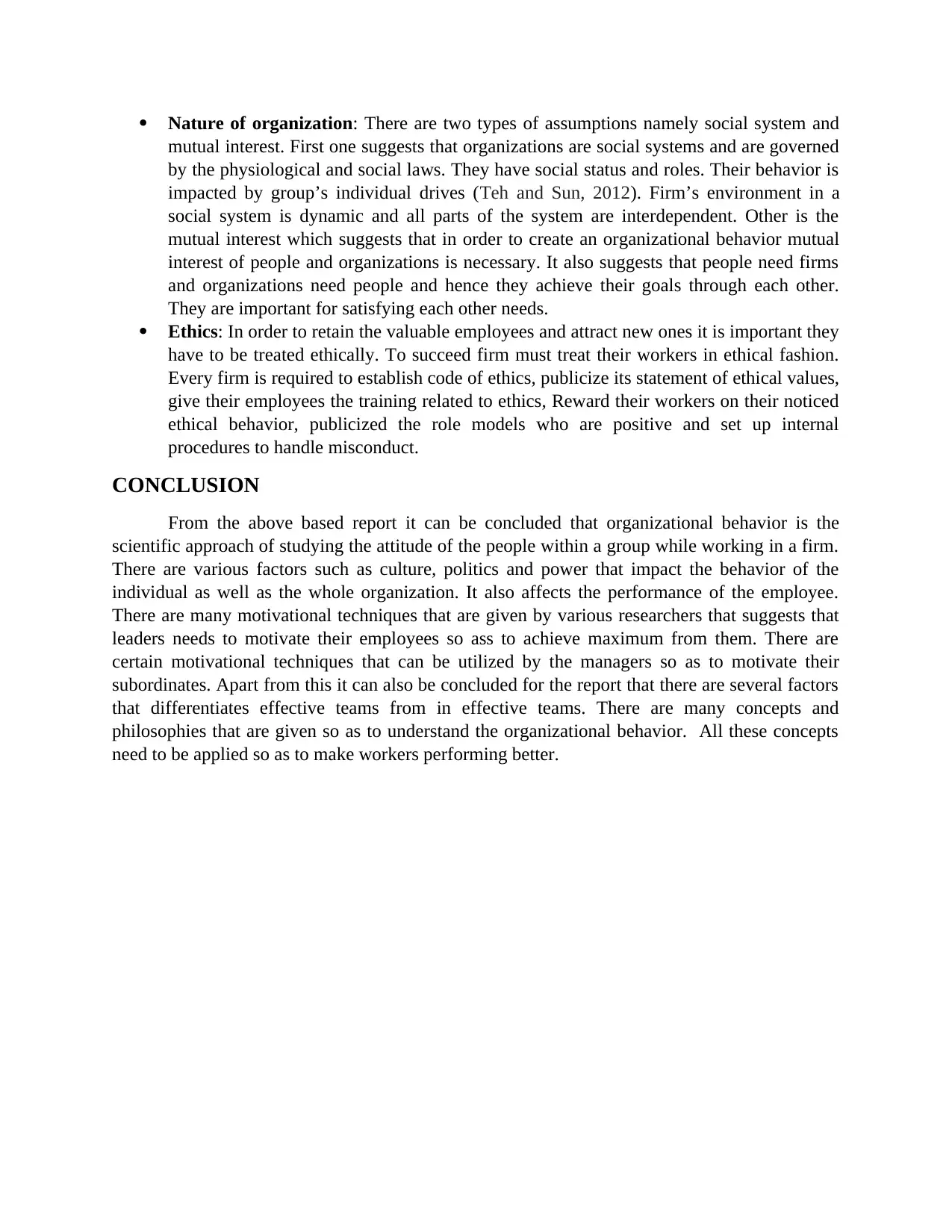
Nature of organization: There are two types of assumptions namely social system and
mutual interest. First one suggests that organizations are social systems and are governed
by the physiological and social laws. They have social status and roles. Their behavior is
impacted by group’s individual drives (Teh and Sun, 2012). Firm’s environment in a
social system is dynamic and all parts of the system are interdependent. Other is the
mutual interest which suggests that in order to create an organizational behavior mutual
interest of people and organizations is necessary. It also suggests that people need firms
and organizations need people and hence they achieve their goals through each other.
They are important for satisfying each other needs.
Ethics: In order to retain the valuable employees and attract new ones it is important they
have to be treated ethically. To succeed firm must treat their workers in ethical fashion.
Every firm is required to establish code of ethics, publicize its statement of ethical values,
give their employees the training related to ethics, Reward their workers on their noticed
ethical behavior, publicized the role models who are positive and set up internal
procedures to handle misconduct.
CONCLUSION
From the above based report it can be concluded that organizational behavior is the
scientific approach of studying the attitude of the people within a group while working in a firm.
There are various factors such as culture, politics and power that impact the behavior of the
individual as well as the whole organization. It also affects the performance of the employee.
There are many motivational techniques that are given by various researchers that suggests that
leaders needs to motivate their employees so ass to achieve maximum from them. There are
certain motivational techniques that can be utilized by the managers so as to motivate their
subordinates. Apart from this it can also be concluded for the report that there are several factors
that differentiates effective teams from in effective teams. There are many concepts and
philosophies that are given so as to understand the organizational behavior. All these concepts
need to be applied so as to make workers performing better.
mutual interest. First one suggests that organizations are social systems and are governed
by the physiological and social laws. They have social status and roles. Their behavior is
impacted by group’s individual drives (Teh and Sun, 2012). Firm’s environment in a
social system is dynamic and all parts of the system are interdependent. Other is the
mutual interest which suggests that in order to create an organizational behavior mutual
interest of people and organizations is necessary. It also suggests that people need firms
and organizations need people and hence they achieve their goals through each other.
They are important for satisfying each other needs.
Ethics: In order to retain the valuable employees and attract new ones it is important they
have to be treated ethically. To succeed firm must treat their workers in ethical fashion.
Every firm is required to establish code of ethics, publicize its statement of ethical values,
give their employees the training related to ethics, Reward their workers on their noticed
ethical behavior, publicized the role models who are positive and set up internal
procedures to handle misconduct.
CONCLUSION
From the above based report it can be concluded that organizational behavior is the
scientific approach of studying the attitude of the people within a group while working in a firm.
There are various factors such as culture, politics and power that impact the behavior of the
individual as well as the whole organization. It also affects the performance of the employee.
There are many motivational techniques that are given by various researchers that suggests that
leaders needs to motivate their employees so ass to achieve maximum from them. There are
certain motivational techniques that can be utilized by the managers so as to motivate their
subordinates. Apart from this it can also be concluded for the report that there are several factors
that differentiates effective teams from in effective teams. There are many concepts and
philosophies that are given so as to understand the organizational behavior. All these concepts
need to be applied so as to make workers performing better.
⊘ This is a preview!⊘
Do you want full access?
Subscribe today to unlock all pages.

Trusted by 1+ million students worldwide
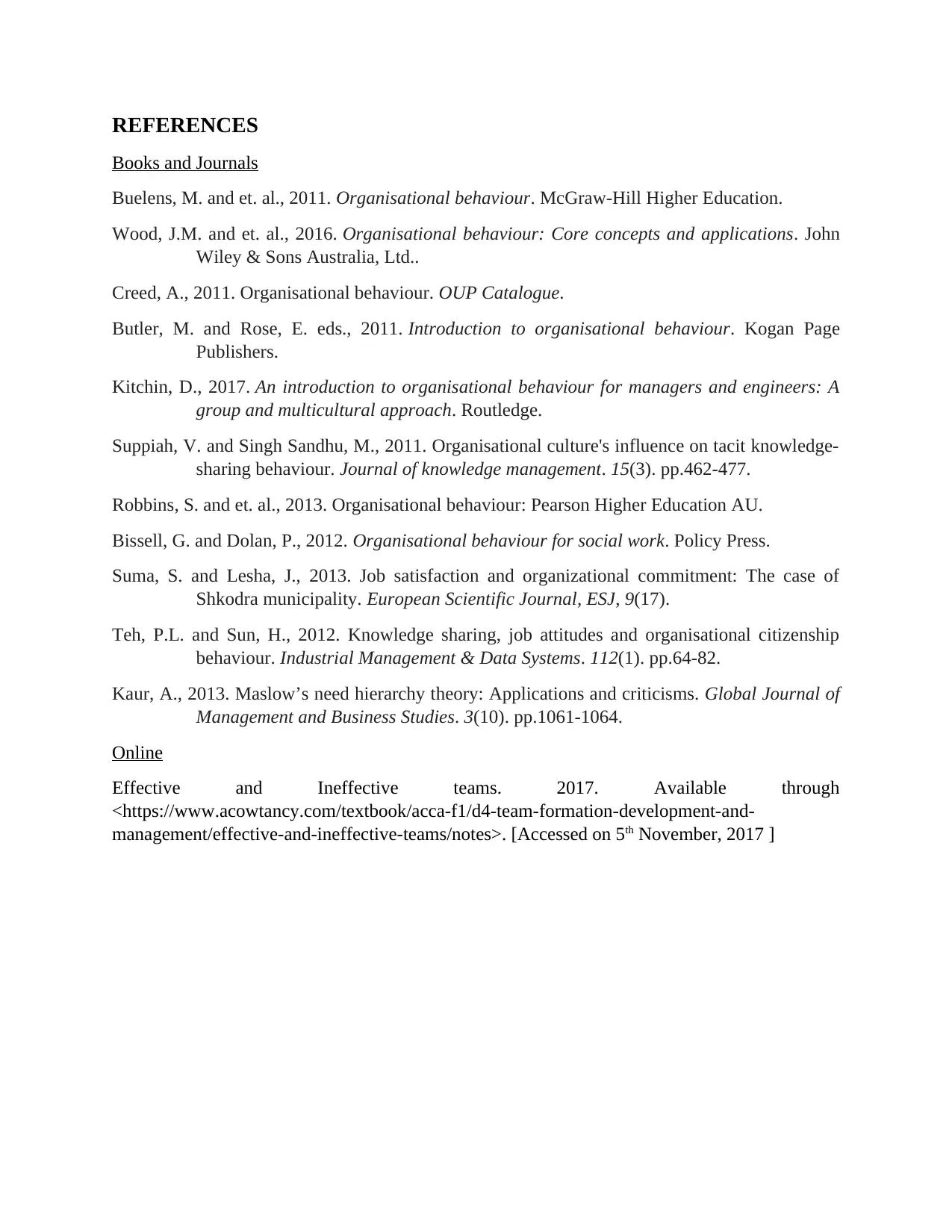
REFERENCES
Books and Journals
Buelens, M. and et. al., 2011. Organisational behaviour. McGraw-Hill Higher Education.
Wood, J.M. and et. al., 2016. Organisational behaviour: Core concepts and applications. John
Wiley & Sons Australia, Ltd..
Creed, A., 2011. Organisational behaviour. OUP Catalogue.
Butler, M. and Rose, E. eds., 2011. Introduction to organisational behaviour. Kogan Page
Publishers.
Kitchin, D., 2017. An introduction to organisational behaviour for managers and engineers: A
group and multicultural approach. Routledge.
Suppiah, V. and Singh Sandhu, M., 2011. Organisational culture's influence on tacit knowledge-
sharing behaviour. Journal of knowledge management. 15(3). pp.462-477.
Robbins, S. and et. al., 2013. Organisational behaviour: Pearson Higher Education AU.
Bissell, G. and Dolan, P., 2012. Organisational behaviour for social work. Policy Press.
Suma, S. and Lesha, J., 2013. Job satisfaction and organizational commitment: The case of
Shkodra municipality. European Scientific Journal, ESJ, 9(17).
Teh, P.L. and Sun, H., 2012. Knowledge sharing, job attitudes and organisational citizenship
behaviour. Industrial Management & Data Systems. 112(1). pp.64-82.
Kaur, A., 2013. Maslow’s need hierarchy theory: Applications and criticisms. Global Journal of
Management and Business Studies. 3(10). pp.1061-1064.
Online
Effective and Ineffective teams. 2017. Available through
<https://www.acowtancy.com/textbook/acca-f1/d4-team-formation-development-and-
management/effective-and-ineffective-teams/notes>. [Accessed on 5th November, 2017 ]
Books and Journals
Buelens, M. and et. al., 2011. Organisational behaviour. McGraw-Hill Higher Education.
Wood, J.M. and et. al., 2016. Organisational behaviour: Core concepts and applications. John
Wiley & Sons Australia, Ltd..
Creed, A., 2011. Organisational behaviour. OUP Catalogue.
Butler, M. and Rose, E. eds., 2011. Introduction to organisational behaviour. Kogan Page
Publishers.
Kitchin, D., 2017. An introduction to organisational behaviour for managers and engineers: A
group and multicultural approach. Routledge.
Suppiah, V. and Singh Sandhu, M., 2011. Organisational culture's influence on tacit knowledge-
sharing behaviour. Journal of knowledge management. 15(3). pp.462-477.
Robbins, S. and et. al., 2013. Organisational behaviour: Pearson Higher Education AU.
Bissell, G. and Dolan, P., 2012. Organisational behaviour for social work. Policy Press.
Suma, S. and Lesha, J., 2013. Job satisfaction and organizational commitment: The case of
Shkodra municipality. European Scientific Journal, ESJ, 9(17).
Teh, P.L. and Sun, H., 2012. Knowledge sharing, job attitudes and organisational citizenship
behaviour. Industrial Management & Data Systems. 112(1). pp.64-82.
Kaur, A., 2013. Maslow’s need hierarchy theory: Applications and criticisms. Global Journal of
Management and Business Studies. 3(10). pp.1061-1064.
Online
Effective and Ineffective teams. 2017. Available through
<https://www.acowtancy.com/textbook/acca-f1/d4-team-formation-development-and-
management/effective-and-ineffective-teams/notes>. [Accessed on 5th November, 2017 ]
1 out of 10
Related Documents
Your All-in-One AI-Powered Toolkit for Academic Success.
+13062052269
info@desklib.com
Available 24*7 on WhatsApp / Email
![[object Object]](/_next/static/media/star-bottom.7253800d.svg)
Unlock your academic potential
Copyright © 2020–2025 A2Z Services. All Rights Reserved. Developed and managed by ZUCOL.





